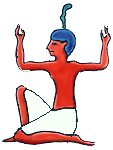For more about Tutankhamen's tomb please click here
From the very earliest times the Kings of Egypt realised that to run a country properly you need well-educated civil servants, so schools (the per ankh, or House of Life) were very important. Each school was run by a Temple or a Government Department.
Boys learned reading and writing, but they also learned gymnastics and swimming, medicine, arithmetic and geometry. If you could read and write you could become a scribe (so the per ankh was often called the Scribes' School) and a boy from even the poorest family who became a scribe could become very rich and powerful, perhaps even Scribe to Pharaoh. So although it was not easy for a poor family to send a son to school, because children were normally expected to help in the fields and parents had to supply school-children with food and clothes, many tried very hard to do so.
Girls could also receive an education. Wealthy families often had their daughters taught at home, and also took in and educated girls from poor homes, to be trained as children's nurses, musicians, temple priestesses, seamstresses, needlewomen or lady's maids - they could even marry into the family! Women were not in any way regarded as inferior to men, and certainly not the property of a man, in Ancient Egypt in the way that they were in Ancient Greece or Rome, or even in Mediaeval Europe!
The Egyptians counted and recorded (wrote down) absolutely everything. We even know what the tomb robbers stole from Tutankhamen's tomb because each chest of jewels had a list of its contents so we know what should have been in it as well as what actually was in it when the tomb was discovered. So arithmetic was very important to them.
For more about Tutankhamen's tomb please click here ![]()
Arithmetic was mainly addition and subtraction, multiplication being done by repeated addition. For example ![]() would be calculated as
would be calculated as ![]()
We think that people first learned to count using their fingers, which is why most ancient people, including the Ancient Egyptians, had a numbering system based on ten. A very few ancient races, particularly people who kept herds of sheep or goats and moved from place to place to find fresh pasture for their flocks, counted on their toes as well as their fingers, so they used a numbering system based upon twenty.
In hieroglyph the numbers were written
![]()



![]()


To the Ancient Egyptians a million was unimaginably large and we think the kneeling figure for a million is the God of the Unending. What we call the mortuary temple, where offerings were made to a Pharaoh after his death until the end of time, was called by the Ancient Egyptians the Temple of Millions of Years.
To get, say, three hundred and forty five the Ancient Egyptians would use three snares, four heel bones and five vertical strokes. But they usually wrote them in the opposite order to us, the units, then the tens, hundreds etc.
Like most ancient people the Ancient Egyptians had no symbol for or understanding of zero, and did not use decimal fractions. They did however use unit fractions, such as one half, one third, one quarter, one fifth, one sixth, one seventh, one eighth etc.
They wrote their fractions as the number with an elongated oval over it, for example they would write one fifth as

Unit fractions are often called Egyptian fractions. There is much more about Egyptian fractions on the Egyptian fraction web site, and people with an interest in (and some knowledge of) mathematics might find it interesting - to visit it click here ![]() .
.
The hieroglyphs for the numbers came from Mark Millmore's Ancient Egyptian web site - this is well worth a visit. To visit it click here ![]()
© Barry Gray June 2000